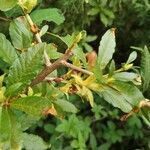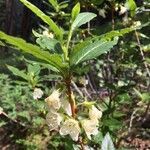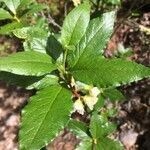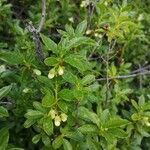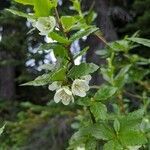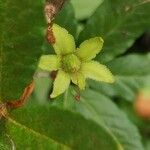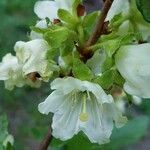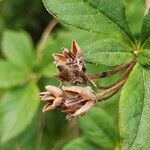Shrubs, to 2.5 m, rhizomatous. Stems: bark ± smooth to furrowed; twigs multicellular eglandular-hairy (hairs un-branched) and unicellular-hairy. Leaves deciduous; petiole multicellular eglandular-and stipitate-glandular-hairy and unicellular-hairy; blade narrowly elliptic or ovate to obovate, 2-9 × 0.8-3 cm, thin, membranous to chartaceous, margins minutely serrate, plane, ciliate when young, eglandular-and stipitate-glandular-hairy, apex acute to ± rounded, surfaces scattered eglandular-hairy, ± glabrescent. Floral bud scales stipitate-glandular-and eglandular-hairy abaxially, margins stipitate-glandular-hairy. Inflorescences lateral (axillary, i.e., above leaf scars, spaced along shoots of previous year), fasciculate, 1-2-flowered; bracts similar to bud scales. Pedicels to 9-15 mm, eglandular-and stipitate-glandular-hairy. Flowers ± radially symmetric, opening soon after (and borne below) expanded leaves, pendulous, very fragrant (similar to vanilla and jasmine); calyx lobes 5-17 mm, eglandular-and stipitate-glandular-hairy, margins glandular-hairy; corolla white, rarely marked with yellow, bowl-shaped, 9-22 mm, minutely unicellular-hairy or glabrous on outer surface, petals connate, lobes 6-15 mm, tube expanding into lobes, 3-9 mm; stamens 9(-12), included, ± unequal, 5.5-14 mm. Capsules borne on erect pedicels, 6-8 × 5-6 mm, stipitate-glandular-, eglandular-, and unicellular-hairy. Seeds with distinct tails; testa closely appressed. 2n = 26.
More
A shrub. It grows 2.5 m tall. The stems are hairy. It loses its leaves during the year. The leaves are 2-9 cm long by 1-3 cm wide. There are small teeth along the edge. The flowers are in groups of 1 or 2 and produced below the leaves. They are white with yellow marks. They have a scent.
Coniferous forests, alpine thickets, stream banks, seeps on rock outcrops, often forming impenetrable thickets just above the tree line and along streams; at elevations from 800-3,500 metres.
